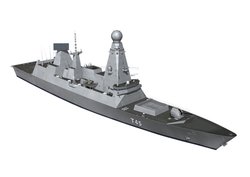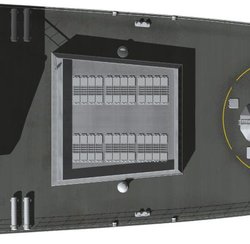Type 45 destroyer
|
|
Rn_type_45.jpg
The UK's Type 45 Destroyer is the state-of-the art future air defence destroyer program of the Royal Navy.
| Contents |
Background
Six ships have been ordered and a total of eight are expected to enter service by 2014. The original planned purchase of twelve was reduced in the MoD's Delivering Security in a Changing World: Future Capabilities review, published in July 2004. The Type 45 design utilises the PAAMS anti-air system, a joint British, French and Italian design, which comprises the SAMPSON fire control and tracking radar, MBDA Aster 15 and 30 missile systems and the 48-cell SYLVER vertical missile launcher, giving the Type 45 a short-range and long-range anti-air capability. The PAAMS system is able to control and coordinate several missiles in the air at once, allowing several tracks to be intercepted, and the SYLVER missile launcher can be upgraded in the future to add more modern weapons if necessary (as they become available).
The Type 45 destroyers will replace the Type 42 Destroyers currently in service with the Royal Navy. The First two, Daring and Dauntless will enter sevice in 2007 and 2009 respectively. The Type 45 is also planned to be given cruise missile launchers if the need arise in the future.
The UK had sought to procure the ships in collaboration with 7 other NATO nations under the NFR-90 project and then with France and Italy through the Horizon CNGF programme, however differing national requirements, workshare arguments and delays led to the UK withdrawing from both and starting its own national project.
Design
The Type 23 frigates were the first UK ships to incorporate signature reduction technology, with the large 7° angle of the bow, the elimination of right angles and reduced equipment on deck. The propulsion system was also chosen to minimise noise, with electric generators providing minimal acoustic signature for the ASW mission. Infrared signature is reduced by cooling devices on the funnels.
The design of the Type 45 brings new levels of signature reduction to the Royal Navy. The equipment on the deck is reduced further, producing a very "clean" superstructure similar to the La Fayette class frigate. There is reduced equipment located on the mast and all docking equipment and life rafts are hidden behind doors.
Armament
Anti aircraft
- Sampson multi-function radar tracks airborne targets
- 48 Aster missiles; a mix of Aster 15 and Aster 30
- 2 Phalanx CIWS
In addition there are 4 Seagnat decoys, which are intended to make incoming anti-ship missiles miss their target.
Guns
- 114 mm (4.5 inch) Mk 8 gun
- 2 x 30 mm guns
Aircraft
- 1 Merlin helicopter (a derivative of the EH101). This will carry Sea Skua anti-ship missiles and Sting Ray torpedoes.
Other
- MFS 7000 sonar
- The ships will have room to carry 60 Royal Marines and their equipment. Space has also been set aside for future weapons, such as cruise missiles (it's likely a version of the Storm Shadow will be fitted, if the decision is taken to fit a cruise missile), anti-ship missiles, or a 155 mm gun.
Propulsion
- Rolls-Royce/Northrop Grumman WR-21 Advanced gas turbine with ICR (Intercooler Recuperator.)
Ships in the class
The first six ships are to be called, Daring, Dauntless, Diamond, Dragon, Defender and Duncan. Two more are planned.
| Name | Builder | Laid down | Launched | In service |
|---|---|---|---|---|
| Daring (D32) | BAE Systems | 2003 | 2005 | 2007 |
| Dauntless (D33) | BAE Systems | 2004 | 2006 | 2009 |
| Diamond (D34) | BAE Systems | 2004 | 2007 | 2009 |
| Dragon (D35) | BAE Systems | 2005 | 2007 | 2010 |
| Defender (D36) | BAE Systems | 2006 | 2008 | 2010 |
| Duncan (D37) | BAE Systems | 2006 | 2008 | 2011 |



